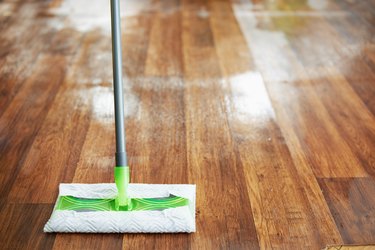Have you ever found yourself sliding across your hardwood floors like a hockey puck on ice? If so, you’re not alone. Many homeowners struggle with slippery hardwood floors, especially during the winter months. But don’t despair! There are multiple effective solutions to restore the traction of your hardwood flooring and make it safe and comfortable to walk on.

Image: manhtretruc.com
Understanding Hardwood Floor Slipperyness: The Culprits Unmasked
Before diving into the remedies, let’s investigate the culprits behind hardwood floor slipperiness:
- Polishes and Waxes: Over time, layers of polish or wax can build up on your hardwood floor, creating a glossy, slippery surface.
- Water and Spills: Even small amounts of moisture can make your hardwood floor slippery, especially if it’s not properly sealed.
- Oil and Grease: Cooking oils or greases can leave behind a residue that makes your floor hazardous.
- Dirt and Sand: Dirt and sand particles can act like tiny ball bearings, reducing traction.
Tackling Slippery Hardwood Floors with DIY Solutions
Before reaching for expensive solutions or floor refinishing, explore these DIY remedies:
- Cleaning and De-glossing: Thoroughly clean your hardwood floor using a mixture of vinegar and water or a commercial hardwood floor cleaner. If the surface is excessively glossy, you can use a de-glossing solution to remove built-up polish or wax.
- Sanding: If cleaning alone doesn’t resolve the issue, light sanding can remove the slippery outer layer of the hardwood. Ensure you use a fine-grit sandpaper (around 120-150 grit) and proceed cautiously to avoid damaging the wood.
- Adding Traction Enhancing Rugs: Well-placed area rugs can provide additional traction, especially in high-traffic areas. Choose skid-resistant rugs with a rubber or cork backing.
Professional Floor Treatments for Long-Lasting Anti-Slip Protection
For a more permanent solution, consider these professional floor treatments:
- Refinishing: Refinishing your hardwood floor involves sanding down the existing surface and applying a new protective coating. Professional refinishing can not only enhance the appearance of your floor but also increase its traction.
- Anti-Slip Coatings: Specialized anti-slip coatings, such as polyurethane with silica particles, can be applied to your hardwood floor to create a non-slip surface.
- Textured Finishes: Textured finishes, like wire-brushing or hand-scraping, add depth and roughness to the floor, which significantly improves traction.

Image: www.pinterest.com
Prevention is Key: Maintaining Non-Slip Hardwood Floors
Once you’ve restored the traction of your hardwood floor, maintaining it is crucial. Here are some preventive measures:
- Regular Cleaning: Regularly clean your hardwood floor with an appropriate cleaner to remove dirt, grime, and oils.
- Prompt Spill Removal: Clean up spills and messes immediately to prevent moisture or stains from making your floor slippery.
- Use Walk-Off Mats: Place walk-off mats at entryways and high-traffic areas to trap dirt and moisture before they reach your hardwood floor.
- Buffing and Polishing: Occasionally, buff or polish your hardwood floor using a machine with a non-slip pad. This helps maintain a non-slip finish.
How To Fix Slippery Hardwood Floors
Conclusion
Slippery hardwood floors can be a safety hazard and damper the enjoyment of your home. Fortunately, by understanding the causes of hardwood floor slipperiness and exploring the remedies outlined above, you can restore traction, enhance safety, and appreciate the beauty of your hardwood floors without any unwanted slides or slips. Remember that preventive measures and regular maintenance are essential to sustain the non-slip properties of your hardwood flooring.